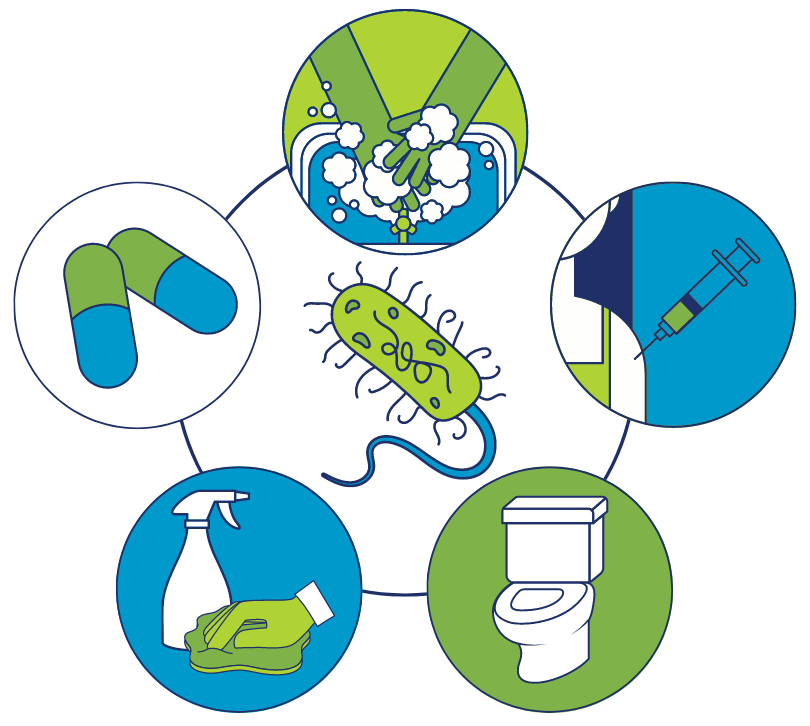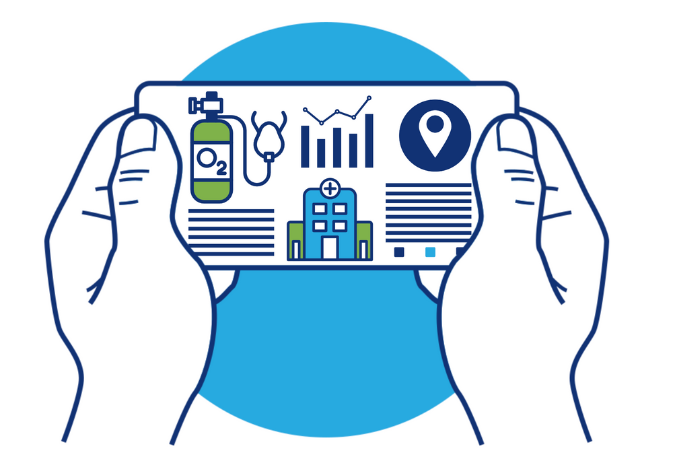
An estimated 7.7 million people die from bacterial infections a year around the world. A growing number of these deaths are caused by bacteria that have developed antibiotic resistance – the ability to thrive in the face of antibiotics. This ability of germs to defy the effects of drugs is called antimicrobial resistance, or AMR.
But why wait to treat these infections after they’ve happened? It’s far better to prevent them from happening in the first place.
Dr. Joseph Lewnard, an associate professor of Epidemiology at the School of Public Health at the University of California Berkeley, is studying ways to prevent infections. Vaccines, better hygiene and sanitation, clean water, and proper and careful use of antibiotics and antivirals can all play a role.
Many governments have done far too little to protect their citizens from infections, Lewnard says. “This has not necessarily been a shining success story,” he says in this episode of One World, One Health.
He helped write one of a series of papers in the Lancet medical journal looking at the problem of drug-resistant superbugs. The numbers are significant.
“Improving infection prevention and control in healthcare facilities including better hand hygiene and more regular cleaning and sterilization of equipment, could save up to 337,000 lives a year,” they write.
They estimate that clean water and sanitation could save another quarter million lives each year.
“Access to improved sanitation facilities (defined as toilets that are not shared with other households and are connected to piped sewer systems or septic tanks) reduces diarrhea incidence by 47 percent,” they point out.
Listen as Dr. Lewnard explains some of the other findings to One World, One Health host Maggie Fox.
Learn more about the struggle to control drug-resistant bacteria, viruses, and fungi in some of our other episodes. We’ve spoken with experts about how vaccines can help prevent the spread of drug-resistant germs, about tracking superbugs in sewage, and the surprising rise of drug-resistant fungi. Experts in drug design have talked to us about the search for new and better antibiotics and how these little organisms are winning an arms race against us. Filmmakers have told us about how storytelling can help people understand the threat while global health specialists explained that good stewardship can keep the antibiotics we have working as they should. We’ve even investigated superbug mysteries, like the case of the killer eyedrops.
Maggie Fox 00:00
Hello and welcome to One World, One Health where we take a look at some of the biggest problems facing our world. I’m Maggie Fox. This podcast is brought to you by the One Health Trust with bite-sized insights into ways to help address challenges, such as infectious diseases, climate change, and pollution. We take a One Health approach that recognizes that everything on this planet — the animals, plants, and people, and the climate and environment — are all linked.
A perfect example of how we’re all connected is the problem of antimicrobial resistance or AMR. This happens when infectious bacteria, viruses, or fungi develop the ability to withstand drugs and other treatments. When a person or animal gets infected with one of these superbugs, it’s harder to cure them, and sometimes infections become completely impossible to treat. It’s such a big problem that the United Nations and other major organizations have focused on it throughout 2024. To help guide these international discussions, the Lancet medical journal commissioned a series of papers led in part by the One Health Trust.
Dr. Joseph Lewnard, an associate professor of epidemiology at the School of Public Health at the University of California, Berkeley, helped write one of these papers, looking at ways to prevent infections in the first place. Simple hand washing can do a lot, so can clean water and vaccines. Lewnard is joining us in this episode to talk about what works.
Joseph, thanks for joining us.
Joseph Lewnard 01:38
Thanks for having me.
Maggie Fox 01:40
Joseph, we’ve been talking a lot about how dangerous these drug-resistant infections are, and how many people they kill every year. But there are ways, and some are simple to prevent infections from happening in the first place. Can we talk about what some of those are?
Joseph Lewnard 01:57
Well, there are several dimensions of what we should do to address antimicrobial resistance and the burden it causes. But the first and perhaps most impactful one will be preventing resistant infections from occurring. One setting out of many that we should be thinking about is of course, within hospitals and other healthcare environments, because many of the most severe, most dangerous, and most difficult-to-treat infections are acquired in healthcare environments.
Maggie Fox 02:23
Can we talk a little bit about what you mean by healthcare environment?
Joseph Lewnard 02:27
The healthcare environment is the first one that we think of, and I think one of the more important ones is hospitals because this is where the most severely ill patients are seen. It is also where patients may receive the most invasive care, for instance, in the context of surgery, or where patients may be stuck in a hospital for long, extended periods. These are some of the circumstances under which the concerns about acquiring dangerous and resistant infections may be greatest.
Maggie Fox 02:56
One would tend to think that a hospital or a clinic should be the safest place you could be, but it’s not. Is it?
Joseph Lewnard 03:04
Unfortunately, I think that it’s not always the case that this (hospital) is the safest place we can be. There are risks of acquiring infections in the community as well. But we do see that the most severe infections that are most likely to cause death, and some that are hardest to treat are acquired in hospital settings. This can also be due to the extensive use of antibiotics in healthcare settings and the selection of some of the most resistant phenotypes (observable traits) of pathogens out there.
Maggie Fox 03:30
One of the things you looked at and talked about in this paper is hand washing. That seems so basic, yet it’s harder to do than it seems. You’ve looked at healthcare facilities, where you would think hand washing would be universal, 100 percent, right?
But you found that health care workers, including nurses and doctors, were only able to follow hand hygiene 43 percent of the time in low-income countries — that’s less than half! And they just hit 65 percent in high-income countries. How can that be?
Joseph Lewnard 04:03
Well, I think that the first thing that we need to think about, especially when we consider low and middle-income country settings, is that in order to be compliant with recommended hand hygiene protocols, the physical infrastructure needs to be there — to make it convenient and routine for people to engage in hand hygiene the way they need to.
There are many settings, including hospitals or healthcare facilities, where hygiene is not easy or convenient to achieve for (healthcare)providers who lack access to the appropriate physical infrastructure or who are swamped with the challenges of delivering patient care under very difficult conditions.
Of course, you mentioned that there is unmet potential even in the higher income settings, which is true, and this is true of many behavioral interventions in general that attaining the 100 percent compliance that we would like to see can be difficult.
Maggie Fox 04:54
You talked about achieving the infrastructure that people need, can we take that to like plain language level, what do you mean by that? Do you mean sinks? Do you mean hand dispensers? What do you mean by that?
Joseph Lewnard 05:04
It can be as simple as accessing a sink with soap. It can also be having delivery of clean water and removal of waste, where that’s not achievable. It can also mean water-free wash stations.
Maggie Fox 05:20
What other types of hygiene can help?
Joseph Lewnard 05:23
Well, as we look beyond just hand washing, this is a cornerstone of preventing infections in healthcare facilities. But we also need to think about the use of sterile instruments and the environmental cleaning and sterilization necessary for patient care to be delivered safely.
Maggie Fox 05:38
So, in other words, clean needles, clean catheters, clean rooms. Okay, what else can be done? How about vaccinations?
Joseph Lewnard 05:46
Well, we looked not just at infections that can be prevented in healthcare facilities, but also at infections that occur in the community, which is where a very large proportion of AMR selection likely happens. So, there are several dimensions of how we need to think about preventing infections in the community. Anything that reduces antibiotic use is important because it is an important part of how we select resistance in bacterial pathogens.
In addition, the delivery of vaccines that prevent resistant infections such as typhoid conjugate vaccines (used to generate stronger immune response), or implementation of improvements in people’s physical infrastructure, such as access to clean water and sanitation in their homes and communities can help prevent infections that either are resistant or that lead to antibiotic use, which we want to ultimately prevent whenever possible.
Maggie Fox 06:35
Some of these antibiotic-resistant infections can be prevented with vaccines, which ones can?
Joseph Lewnard 06:43
This is an important focus, especially for typhoid conjugate vaccines. So, infections with typhoid around the world have seen an increase in the proportion that are resistant to some of our most important medications for treating typhoid. So, the delivery of typhoid conjugate vaccines over the last four or five years has been an important part of how we aim to mitigate the burden of resistant typhoid, which of course can be fatal.
In addition, there are other vaccines that target pathogens for which resistance might be of concern as well. Some of these include Streptococcus pneumoniae, which is an important bacterial pathogen for which we have pneumococcal conjugate vaccines being used in most countries now. Others include Group B streptococcus (GBS), or Shigella, for which vaccines are in the pipeline.
Maggie Fox 07:29
How about if you vaccinate people against other infections, ones that aren’t necessarily drug-resistant infections?
Joseph Lewnard 07:38
This is one of the most important and interesting stories about the role that vaccines and other interventions play in reducing the burden of drug resistance. Most of the impact that we estimate can be achieved through vaccination occurs through a reduction in antibiotic treatment of viral infections like influenza, respiratory syncytial virus (RSV), and rotavirus, which are all important contributors to acute respiratory and diarrheal infections that account for most antibiotic treatment in children, even though their etiology (cause or origin) is rarely known at the time patients seek care in clinical settings.
So very often, what happens is, people unnecessarily receive antibiotics to treat these infections, both due to patient preferences for receiving antibiotics when they are ill and the difficulty that (healthcare) providers face in navigating the potential to treat an infection for which they don’t necessarily know whether bacteria or viruses are at play in causing it.
Maggie Fox 08:38
So, in other words, if people get a virus, the antibiotics aren’t going to help. But doctors often give them antibiotics anyway, both because people ask for them and to be safe.
Joseph Lewnard 08:51
That’s right. (Healthcare) providers face a dilemma in this situation where maybe there is a risk that a bacterial pathogen is not necessarily the cause of the illness that somebody is experiencing.
However, they have only one opportunity to treat that patient, especially in low-resource settings. So, using antibiotics might be an important first-line approach, even when there is only a partial likelihood that bacteria are responsible for the illness that the individual is experiencing.
Maggie Fox 09:19
Reducing the use of antibiotics in the first place is a major goal. Could you tell us about other ways to reduce antibiotic use?
Joseph Lewnard 09:30
Many infections that occur each year result in antibiotic treatment, some of which are bacterial, some viral, and some are caused by other types of organisms or even chronic disease progress.
Unfortunately, we don’t necessarily have perfect interventions against each of these specific (causes) etiologies that we might consider here. However, we know that improving the quality of physical environments that people live in can play an important role in reducing their risk of illnesses that result in antibiotic treatment. For instance, people experience a lower risk of diarrheal infections and acute respiratory infections when they have access to clean water, appropriate sanitation infrastructure for the removal of waste, hand washing facilities with soap, and if they take basic precautions, that we often take for granted in high-income countries, can help reduce the vast variety of infections and antibiotic use.
Maggie Fox 10:30
You mentioned some stuff that many people might take for granted like access to clean toilet facilities where they’re not sharing one toilet with a lot of other people.
Joseph Lewnard 10:41
This is a great example of one of the key interventions that we need to make more widely available. There are many settings, where toilets are not available, or where waste disposal does not ensure that people will not come in contact with it again, or where it may be inconvenient to use latrines or sanitation facilities simply because they’re not located in a place that is near to where people live, or in a situation where accessing the facilities may not be safe.
There is an additional concern associated with going out into community sanitation facilities or making use of shared sanitation facilities.
Maggie Fox 11:21
When you talk about access to vaccines, can we explain that to people? Does that mean that they’re brought to countries, they’re brought to your homes? What do you mean by that?
Joseph Lewnard 11:30
How we deliver vaccines can look different in different places. One consideration is that countries need to commit to having these vaccines in their National Immunization Programs for children. So, the first barrier to acquiring all the vaccines that we’d like people to receive is knowing if the countries are committed to delivering these vaccines and making them available.
The second is, that even in countries where vaccines have become part of their immunization program, there might not be universal uptake, perhaps due to a lack of access to medical care, or an inability to deliver vaccines too hard to serve populations, especially those that are residing in rural locations, where delivery of vaccines poses challenges, or where there is vaccine reluctance or hesitancy.
Maggie Fox 12:17
Can you give us some examples of countries that are doing it right and countries that aren’t necessarily meeting some of these vaccine targets? There might be countries that surprise you.
Joseph Lewnard 12:28
Rwanda is an interesting example of a country that is ostensibly a low-income setting. Unfortunately, people do not have access to the same standards of living and life expectancy as the rest of the world. However, they’ve made enormous strides in the delivery of primary healthcare services, and (their) vaccine coverage reflects this. They do very well with delivering vaccines to children, and their Expanded Program on Immunization would be probably seen as a success.
Brazil is another example where even though many of the people might lack access to some of the services, we take for granted, for instance, those living in favelas or even relatively remote communities still have access to vaccinations and do very well and are also accepting of vaccines in large parts.
There are also countries that we think can do better but do not, and unfortunately, the United States is an example of this, where primary healthcare leaves a lot to be desired, acceptance of vaccines remains inadequate, and some of the benefits that we could achieve in the prevention of infectious disease are not realized as a result.
Maggie Fox 13:30
This is so interesting. What are some other things that you see that countries or governments can do?
Joseph Lewnard 13:35
One of the parts here that I think is essential, aside from ensuring that vaccines and other health interventions are broadly available and used in populations, is ensuring broadly available and used in populations, is ensuring that water and sanitation infrastructure is delivered at the highest level that can be attained. To date, some of the investment in water and sanitation infrastructure for low and middle-income countries settings has either been inadequate or non-existent or has focused on interventions that only partially come towards the goal we need to attain.
For instance, installing but not maintaining low-cost and convenient hand washing, sanitation, or other facilities. The standard of water sanitation and hygiene that’s needed to prevent infections is higher than these temporary or slapdash interventions we’ve seen in the past.
Trials undertaken recently in places like Bangladesh, Kenya, Mozambique, and other settings have shown that low-cost, suboptimal interventions that do not make high-quality water and sanitation facilities easily and conveniently accessible to people don’t achieve what we want to achieve in preventing infections.
So, I think this is an area where we need to think of what sanitation and hygiene interventions look like in places like the United States and Europe and high-income countries and try to meet that standard to ensure people who currently do not have access to that standard of water, sanitation, and hygiene can attain it.
Maggie Fox 15:07
What you’re saying is cheap and quick doesn’t always work.
Joseph Lewnard 15:11
Unfortunately, that’s the case.
Maggie Fox 15:13
Wow Joseph, this gives us so much to think about. Thanks very much for taking the time to join us on the podcast.
Joseph Lewnard 15:19
Thank you for having me. It’s a pleasure to talk to you.
Maggie Fox 15:23
Listeners. If you enjoyed this podcast, please share it. You can learn more about this podcast and other important topics at onehealthtrust.org and let us know what else you’d like to hear about at
[email protected]. Thanks for joining us.
Guest

Dr. Joseph Lewnard is an Associate Professor of Epidemiology at the School of Public Health at the University of California, Berkeley. He conducts studies of the natural history and transmission dynamics of respiratory pathogens and the effectiveness of countermeasures. He is a Senior Fellow at the One Health Trust. His work with OHT includes studies of the burden of antimicrobial resistance preventable by public health interventions such as vaccination and studies on the epidemiology of SARS-CoV-2 in south India. Outside of this work, he co-leads the California Center for Outbreak Readiness, a CDC-funded Center for Innovation in infectious disease modeling and analysis based at UC Berkeley and Kaiser Permanente Southern California. He is a standing member of the NIH ASPB study section, a fellow of the Emerging Leaders in Health and Medicine of the US National Academy of Medicine and the Kavli Frontiers of Science fellow of the National Academy of Sciences, and a recipient of the Early Career Research Excellence Award from the Association of Schools and Programs in Public Health.
Credits
Hosted and written by Maggie Fox
Special guest: Joseph Lewnard
Produced and edited by Samantha Serrano
Music composed and sound edited by Raquel Krügel







